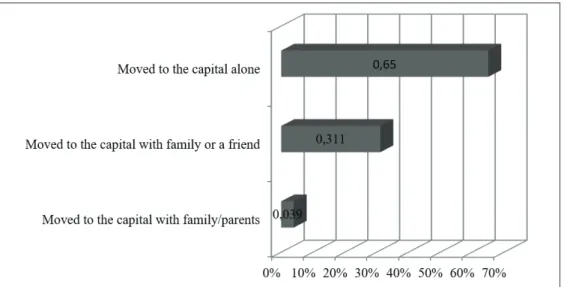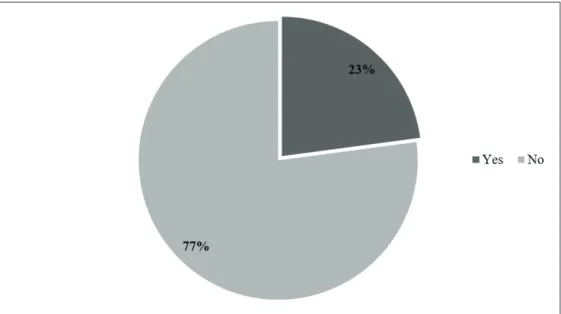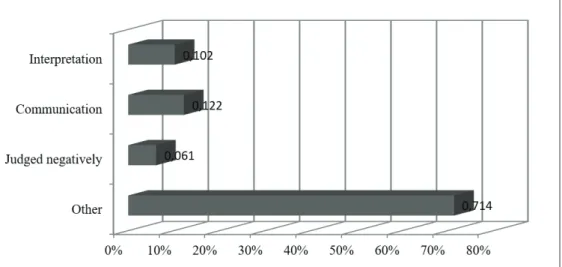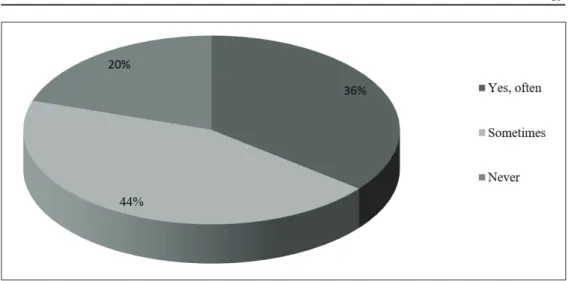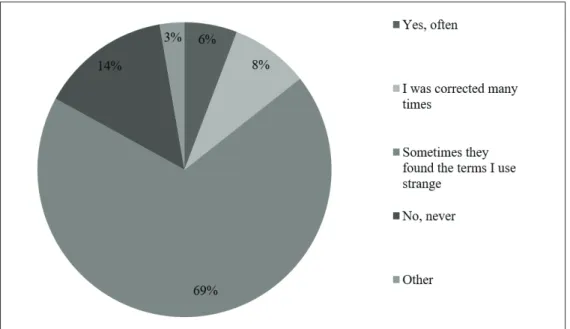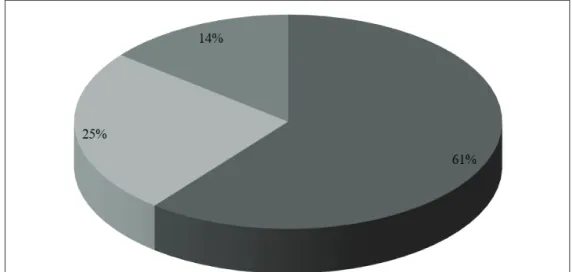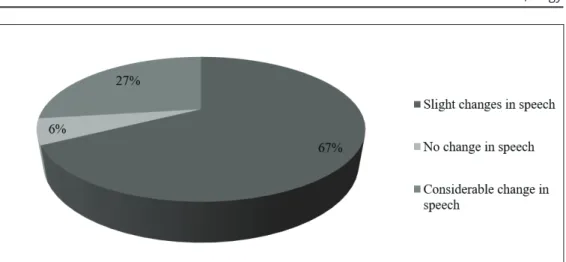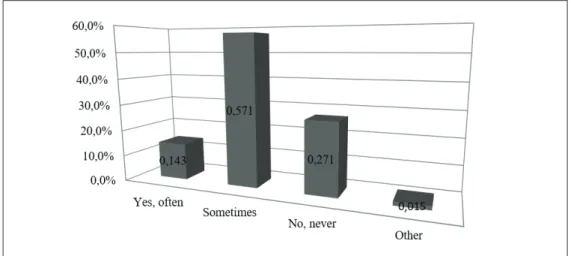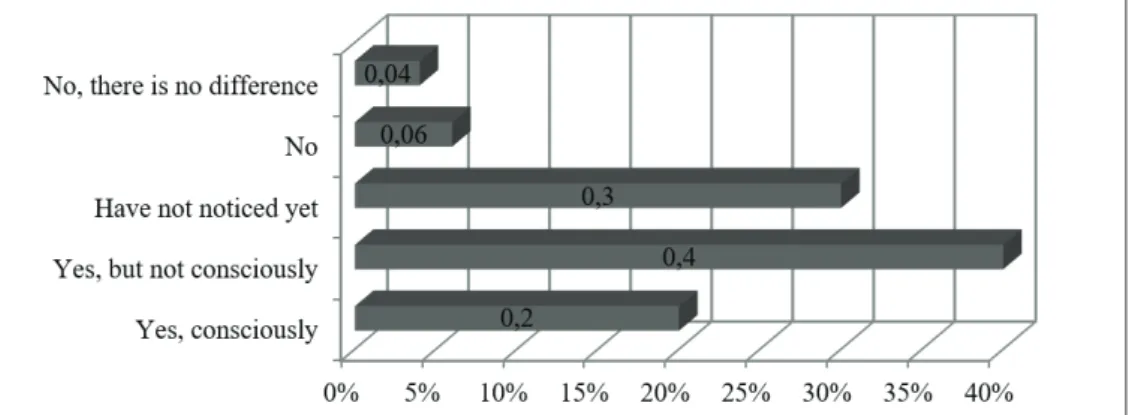NATÁLIA NAGY
ATTITUDES TOWARDS HUNGARIAN LANGUAGE VARIETIES ABROAD
11. Introduction
Language use is one of the primary forms of communication that tell a lot about the speaker. At the same time, language competence can help us choose the right language variety and style for a given situation. Language adaptation makes it easy to find accordance with the current audience.
A given language lives in several variations, resulting in different, closely related linguistic varieties (Adger 2006; Borbély–Vargha 2010; Lőrincz 2011).
William Labov was the first to study everyday spoken language; in his opinion, one has to start from the basic language varieties used in everyday communi- cation (Labov 2009). According to Labov, basic language is “a language acquired in pre-adolescent years. It is an empirical observation that «basic language» is of a very regular nature. There are inherent shifts in the «base language», but the rules that govern these shifts seem more regular than the more elaborate rules that the speakers later acquire in the «higher» styles. Every speaker has a
«basic language» in at least one particular language” (Labov 1988: 23).
The community in which we live, the environment significantly influences our speech style and vocabulary development. For the individual, the utter- ances he or she hears from childhood are natural. In sociolinguistics, the social contacts one is surrounded by are called social networking. It shows the num- ber of members of a community, the relationship of members to one another.
When members interact with each other much more intensely than with out- siders, they form a closed network in which stronger norms define behav- ior and there is a strong sense of respect towards their own norms. This is reported in a study by Lesley and James Milroy in Belfast, which has shown that the individual’s speech is primarily determined by the immediate environment (Milroy–Milroy 1978). Communities are bound to their own language varieties, even if they are negatively discriminated against. This is also proved by Peter Trudgill’s research in Norwich (Trudgill 1974).
1 The study was supported by the Visegrad Scholarship Program (51810956).
1.1. The aim of the research
The purpose of this study is to highlight the difficulties that a Hungarian speaker born outside of Hungary has to face in terms of language use when integrating into the capital. Due to the flexibility of the individual, he/she is able to adapt to his/her environment in the use of language, so in some cases, during a long stay, the extent of the differences is hardly perceptible or noticeable. On the way to reaching this state, however, we often find comments that reflect obser- vations of our immediate environment in relation to our speech. These com- ments can sometimes make one smile, but can also be offensive. In the course of the research, we examine these feedbacks and the reasons behind them.
1.2. Research methodology
During the research I worked with a quantitative method, I conducted a ques- tionnaire survey, in which the questionnaires were filled in individually, in writ- ing, regardless of location, via the internet.
I used Google Forms to create and complete the questionnaire, which allowed me to see the answers and the completed results I had received through its visualization tools.
The study was conducted between August and September 2018. The ques- tionnaire was filled in by members of groups created on social network sites for university and college students.
1.3. The informants
Respondents were Hungarian-speaking youngsters of Transcarpathian, Transylvanian and Upper Hungarian descent. I consider the denomination of Transcarpathia as an important factor, because most informants defined them- selves as of Transcarpathian origin, which is an important national identity factor for Transcarpathian Hungarians (Csernicskó–Soós 2002; Molnár–Orosz 2007). More than half of the respondents were from Transcarpathia (40 peo- ple), supplemented by 10 people from each of the other regions (Transylvania, Upper Hungary and Vojvodina).
The age of the informants ranged between 19 and 30 years. The reason for the choice was that most people in this age group can report ongoing univer- sity studies, so they are more likely to meet the Hungarian written and spoken language standard. As a result, they recognize the differences and similarities between their own language varieties and the one spoken in the capital.
The year of relocation to the capital was mainly marked as 2012 (18.6%), 2014 (22.9%) 2015 (27.1%), and 2016 (11.4%). The majority of the respondents had been living in the capital for at least 2 years, but some others who relo- cated in the previous years also helped me in my research (see Figure 1).
Figure 1. Year of relocation of data providers to Budapest
Respondents mostly relocated to the home country alone (65%) or with a friend or girlfriend (31.1%), with a negligible number of people moving with their family or parents (3.9%). The latter fact is also related to the age of the informants, as during the pre-family period a young person is more willing to start a new life in a new country and, in addition, doing so as a student may make his or her situation even easier (see Figure 2).
Figure 2. Answers to the question “With whom did you move to Budapest?”
1.4. Research hypotheses
With this research I wanted to confirm or disprove the following statements:
1. After their migration, Hungarians from beyond the border discover sig- nificant differences between their own language variety and the one used in Hungary.
2. They often receive comments that they speak inappropriately or stran- gely.
3. When communicating with speakers from Hungary, people who are from beyond the border sometimes use Ukrainian / Romanian / Slovak / Serbian words and expressions.
2. Results
As Transcarpathian, Transylvanian, Upper Hungarian and Vojvodina language varieties have already been mentioned in the literature as Hungarian lan- guage varieties abroad, the first questions in the questionnaire were related to whether the informants had problems originating from their specific Hungarian language variety. 77.1% of the responses show that, despite comments on dif- ferent nationalities, varieties indicating country of origin do not pose a problem in the new environment, and only 22.9% of the informants see a problem here (see Figure 3).
Figure 3. Did you have a problem in your new place of residence due to your specific speech?
Approximately 50% of respondents from Vojvodina experienced communi- cation problems during the use of language. For other areas, similar feedback rates are below 30%.
It should be noted that only 6.1% reported ridicule or negative judgment, while the other cases were simply misinterpretations or miscommunications.
Most (71.4%) were considered to be special because of their pronunciation (see Figure 4).
Figure 4. Feedback on speech
The next question was to reveal the feelings that came from the peculiarity of their speech. According to the results, 51.4%, the majority of the respon- dents never, 27% were rarely disturbed by these problems. Only 21.6% of the informants found this extremely disturbing. In other words, the migrants were not disadvantaged by their language use.
“You speak Hungarian nicely for a Ukrainian,” this is what I often heard from people who learned that I live in Transcarpathia, Ukraine. This motivated the next question, which was to determine the frequency of this phenomenon.
35.7% of the respondents met this phenomenon frequently and 44.3% only occasionally. 20% never received a similar comment (see Figure 5).
Figure 5. “You speak Hungarian nicely for a Ukrainian.” Have you ever met statements like this?
About 70% of informants of Vojvodina origin reported receiving similar comments following their resettlement, while only a few similar answers came from other areas. Those who indicated in the questionnaire that they had sim- ilar experiences were given an optional question as to what this comment trig- gered.
67 of the 70 respondents answered the question, the majority was shocked by the reaction of the motherland speakers (28.6%), sometimes they felt dis- turbed by these expressions (17.1%), while the remaining 30% were not dis- turbed by this phenomenon. Only 5 people (7.1%) found such comments offen- sive.
Other answers were also given:
(1) Büszke vagyok arra, hogy több nyelven beszélek! ‘I’m proud to speak more languages!’
(2) Gyakran mondják, hogy szépen beszélek, de nem vmihez képest, hanem objektíven, anélkül, hogy tudnák, hol születtem. ‘It is often said that I speak nicely, but objectively, without knowing where I was born.’
(3) Eleinte megdöbbentett, aztán egy idő után már viccesnek találtam. ‘At first I was shocked, but after a while I found it funny.’
(4) Engem nem zavart, de mondtam nekik, hogy figyeljenek oda és járjanak utána, mert másoknak bántó lehet ‘I wasn’t bothered, but I told them to pay attention to this because it might be hurting others.’
The next question was whether the respondents had received feedback that they were speaking strangely or incorrectly. 68.6% of respondents replied that some terms they used were found strange by speakers living in Hungary, and 8.6% reported that these speakers corrected their language use – telling them
that what they said was inaccurate (mainly from Vojvodina). Only 14.3% said they had never received a similar comment from speakers living in Hungary (see Figure 6).
Figure 6. Have you received any feedback that you speak Hungarian strangely or incorrectly?
In other words, according to the data, speakers of the motherland often find the language use of Hungarians living abroad strange, but they do not correct it or mock it.
The respondents also stated whether they think the majority of Hungarians in the motherland speak Hungarian correctly or incorrectly.
According to most of the answers, there is no big difference between the motherland and the respondents’ own speech, and both language varieties were considered equally correct and beautiful (44.3%). 27.1% of the respon- dents feel that although the language use of the speakers of the mother- land cannot be called inappropriate, it is still noticeably different from the Hungarian language varieties abroad (about 40% of the respondents in Vojvodina). A further 21.4% believe that Hungarians in the language spoken in the motherland is unpolished (mainly speakers from Upper Hungary and Transcarpathia), and 7.1% believe that the language variety spoken in the motherland is definitely incorrect. Interestingly, 80% of those who consider language use inappropriate in the capital are men.
Géza Bárczi’s research, conducted in the early 1930’s, concludes that the interesting features of the “speech in Budapest” may have come from the argot. However, it is by no means certain that “Pest’s speech” is the same as literary Hungarian or “common language”, even if these concepts are linked
to literacy, with Budapest as its center. This is because while literary lan- guage is an abstract set of rules, the “Pest language” is alive and constantly changing (Bárczi 1932). Samu Imre in his article Where do they speak the best Hungarian? sought an answer to the question as to which dialect is consid- ered the most beautiful by native Hungarian speakers. He concluded that, according to the interviewees, nice speech is mainly manifested in pronun- ciation (Imre 1963). Miklós Kontra also reviews the problem discussed: what is nice Hungarian language and what is ugly? He found the main attributes of nice and eloquent speech to be courtesy, determination, and accuracy (Kontra 2003). In another study, Katalin Fodor and Ágnes Huszár also dis- cuss this issue. A total of one hundred students studying in Budapest were asked which language variety they considered to be beautiful and less beau- tiful They played recordings made in different dialects, including dialects in Hungary and abroad. The results showed that informants rated the lan- guage variety most independent of dialectal features as the most beautiful (Fodor–Huszár 1998).
Through the questions in the questionnaire I tried to reveal the relation- ship of the informants to the most beautiful Hungarian speech and their opinion about it: Who do you think speaks better Hungarian? 60.7% of the respondents think that Hungarian is equally beautiful everywhere, while 25% think that Hungarians living abroad speak Hungarian much nicer than in the motherland. In contrast, the number of those who would favor moth- erland speakers because of their nicer speech is negligible (see Figure 7).
Figure 7. In your opinion, who speaks better?
More than half of the respondents said that Hungarians from Transylvania speak the most beautiful Hungarian, and it is noteworthy that Transylvanian Hungarians also consider Transylvanian Hungarian to be the most beau- tiful variety. This was followed by 11 answers all naming Transcarpathian Hungarian as the most beautiful, all of whom were of Transcarpathian descent. This latter conclusion is in complete agreement with the results of István Csernicskó’s research This is the most beautiful for us because we speak it. Csernicskó stated that the Hungarians of Transcarpathia are essentially positive about their own local or regional language varieties (Csernicskó 2008). In the remaining few answers, the Vojvodina and the Upper Hungarian and the Palóc dialect were mentioned as the most beautiful. There were also respondents who noted philologists or educated people as the answer instead of their origin, but some expressed their thoughts instead of a spe- cific answer: no mother could pick a favorite child; every dialect is beautiful in its own way.
When one drifts into a new environment, one’s behavior is to some extent adapted to the standards of an already mature community so that it fits in as much as possible. This is no different in language use. Language use is in itself an adaptation process, as it depends on communicative needs and situations.
From a pragmatic point of view, language adaptation can involve three interrelated steps, namely choice, negotiation and adaptation, as suggested by Nóra Csontos and Csilla Ilona Dér in their work on foreign language learn- ing (Csontos–Dér 2018).
In my opinion, we can talk about these processes not only when learn- ing and interacting with foreign languages, but also while encountering a new language variety. These eventually result in a linguistic adaptation that helps the speaker integrate into the new language.
The answers to the following question show how the respondents feel about changes in their language, whether they have experienced any change in their language use since they migrated. 67.2% of respondents say that their speech has changed only slightly from the beginning, and that they still preserve its essential features. According to 27.1%, their lan- guage use changed significantly during their time in the capital, which is not a surprising result due to the flexibility of language use due to the age of the informants. The respondents are mainly students of Vojvodina and Transcarpathian origin. Only four believe that their speech has not changed at all since moving, accounting for 5.7% of the responses. They are mainly women of Transcarpathian origin (See Figure 8).
Figure 8. Have you experienced any changes in your language use since you relocated?
Those who experienced a change in their own language use had the option of answering the following question about how the changes they perceived were manifesting. It was possible to mark multiple answers.
According to the answers received, 38% of the respondents experienced changes in their vocabulary: they used new words and phrases and their vocab- ulary had significantly expanded. In addition, 29% of respondents indicated that they were using different words for the same terms as before. I would highlight the following answers:
(5) Szerintem ez foglalkozástól függ, multinacionális illetve irodai környezetben nagyobb mértékben kell odafigyelni az érthetőségre és a szavak használatára, így talán azt mondhatom el hogy néhány szó helyett az érthetőség érdekében mást használok.
‘I think it depends on the profession, in a multinational or office environment, I have to pay more attention to clarity and use of words, so maybe I can say that I use other words for clarity.’
(6) Kevésbé használok szlovákizmusokat.
‘I use Slovakisms less.’ (See Figure 9)
Figure 9. If your speech has changed, how do you think this manifests itself?
Returning to the various interference phenomena, the following question focused on whether respondents were using Ukrainian / Romanian / Slovak / Serbian words and expressions in their conversations with speakers of the motherland. Based on the results, more than half of respondents use foreign words learned in their home environment when talking to these speakers from time to time (57.1%), and another 14.3% use these terms very often, (about 40% of the respondents from Vojvodina). Only 27.1% say they do not use these features from their home environment (see Figure 10).
Figure 10. Do you use Ukrainian / Romanian / Slovak / Serbian words and expressions in your conversations with speakers from the motherland?
We can state that Ukrainian / Romanian / Slovakian / Serbian borrowings are used in the language of Hungarians from beyond the border when talking to speakers of the motherland.
The next question was to find out whether respondents were adapting to the speech of the speakers from the motherland.
This issue is a controversial one, as it has been a topic of debate for years if minority Hungarians across the border should really adapt in writing and speaking to the standard that is customary in Hungary, or adhere to the linguis- tic traditions of their region and its linguistic features due to its bilingualism.
However, according to Gábor Tolcsvai Nagy, since the regional standard also exists in Hungary, he does not see an obstacle to the use of specific Hungarian language varieties across the border, especially when it comes to differences in vocabulary and pronunciation resulting from the presence of bilingualism or multilingualism. In his view, regional language can be sophisticated, and for the survival of our nation, it has to be (Tolcsvai 2004).
Most informants (40%) respond that they are not consciously adaptive, while only 20% say they are changing their language use in the company of Hungarians from Hungary on purpose. Only 7 admitted that they did not adapt at all. 50% of the informants from Upper Hungary are consciously adapting, with some reporting that they have compared their changed speech to that of the motherland. This also proves the need for linguistic awareness during speech in order to list and decide on certain expressions (See Figure 11).
Figure 11. When talking to motherland speakers, do you adapt to their languge use?
However, these results can be compared with another attitude study, which found that 90% of Palóc speakers had tried to conceal their dialect quite often or at least a few times. The reason for this in the given research was mainly to avoid some unpleasant situations (Vandová 2013).
At the end of the questionnaire, the informants had the opportunity to write down any personal story, experience with the issues they were willing to share.
Of course, this was only an optional open-ended question.
Only a few people made use of this opportunity. Here are some examples.
(7) Az anyaországi fiatalok, nem értik és ismerik a külhoni magyarok által hasz- nált mondásokat (hétköznapi bölcsességeket), nehezen tudják értelmezni azo- kat.
‘Young people in the motherland, they do not understand and know the proverbs (common wisdom) used by Hungarians abroad, and have difficulty interpreting them.’
Unfortunately, the author of the comment did not provide an example for the case mentioned, but based on his questionnaire we can say that this respon- dent is of Transcarpathian origin. The influence of the Ukrainian language in the area can also be demonstrated in language use, including phraseology. The most colorful local Hungarian phraseologisms of foreign origin include those that have only been partially translated into Hungarian, or where the Hungarian text has been varied. These include, for example, sírva pujdes domu (‘go home crying’) or daj bozse szerencse (‘God, give good luck’) (Csernicskó 2008).
(8) Eleinte sokszor nem értettek engem, én meg nem tudtam mi a baj, mert nálunk mindenki megértette volna ugyanazt a mondatot. De ahogy teltek az évek, lekopott ezeknek a szavaknak a nagy része a beszédemből, de a szórendem néha még más, mint amit itt használnak.
‘At first, they often didn’t understand me, I didn’t know what was wrong, because everyone at home would have understood the same sentence.
But as the years have gone by, most of these words have fallen out of my speech, but sometimes my word order is different from the one used here.’
The comment comes from a Transcarpathian girl who moved to the Hungarian capital 4 years ago. As the questionnaire shows that she was a stu- dent of the Hungarian Grammar School of Beregszász, the reason for the incom- prehensibility is inexplicable. In my experience, those who are former students of the same grammar school use almost the same variant as used in Hungary.
However, the fact that the person was born and raised in Tiszaújlak based on the completed questionnaire may be an explanation. Although more than 80%
of the population of this village is Hungarian, the majority of Hungarian families enroll their children in the Ukrainian school of the village. If the author of the comment went to an elementary school with Ukrainian language of instruction, this could have a big impact on her adult language use.
(9) Mikor felutaztam Budapestre, akkor döbbentem csak rá, mennyi szerb szót használunk otthon (vagy szerb szavakat magyarosítva). Ezeket már szinte teljesen kidobtam a használatból, ha magyarországiakkal beszélek, viszont ha hazautazom, egy-két napon belül visszaáll a régi, otthoni beszédem.
Ugyanúgy megjelenik a tájszólás, megjelennek a szerb szavak. De az új, mag- yar szavakat is használom, amiket itt tanultam meg Budapesten. És itt nem a szlengre gondolok, hanem szépirodalmi szavakra.
‘When I travelled to Budapest, I realized just how many Serbian words we use at home (or Serbian Hungarian words). These are almost completely discarded when I speak with Hungarians, but when I go home, my old lan- guage use will be restored within a day or two. The dialect appears in the same way, Serbian words appear. But I also use the new Hungarian words I learned here in Budapest. And I do not mean slang, but literary words.’
(10) A „jaj, de szépen beszél magyarul, ahhoz képest, hogy...” kezdetű mondatot először Budapesten, a Bevándorlási Hivatalban hallottam az ügyintézőtől.
Ez valóban meglepett, mondanom sem kell. A megdöbbenéstől röviden fel is vázoltam a családfám, és elmagyaráztam, hogy az én anyám-apám is magyar, és vagyunk még így néhányan az országhatáron túl.
‘I first heard the phrase “oh, but you speak nice Hungarian for some- one who is…” in the Immigration Office in Budapest. It really surprised me, needless to say. In my amazement, I briefly outlined my family tree and explained that my mother and father are also Hungarians, and there are still some of us beyond the borders.’
(11) A bevándorlási hivatalban megkérdezték, hogy a „srpsko” (szerb, az állampol- gárságom) az valamiféle középső név? Akkor megdöbbentem a tudatlanságon, ma már jót nevetek rajta.
‘At the immigration office, I was asked if “srpsko” (Serbian, my national- ity) was some kind of middle name? Then I was startled by this ignorance, but today I have a good laugh at it.’
In both cases, the authors of the comments above are young girls of Serbian origin. From the above reports, we can conclude that they do not indicate neg- ative discrimination, only misunderstandings due to ignorance or lack of histor- ical knowledge, which in my view does not warrant further investigation.
These stories provide insight into only a few cases of Hungarians living abroad, but they suffice to make the reader think or remind them of the expe- rience they had to face when moving to the capital.
3. Summary
As a result of the attitude survey after their resettlement, Hungarians from across the border discover significant differences between the motherland and the Hungarian language varieties they use.
Motherland speakers often find the language of Hungarians living abroad strange, but they do not generally correct or mock it.
During their visits at home, the respondents mostly return to their native variety, and the effect of the Hungarian language in the motherland is only partially felt in their speech.
When communicating with speakers from the motherland, those who come from beyond the border sometimes use Ukrainian / Romanian / Slovak / Serbian words and expressions.
The speech of Hungarian youngsters beyond the border will vary depending on whether they are talking to Hungarians in the motherland or to those living beyond the border.
All in all, despite their differences, young people from Hungarian minorities are very similar in some respects: they face the same challenges during their relocation to their mother country, regardless of the area they come from. They all face the fact that the topic of national identity and dialect is almost con- stantly on the agenda, which is why I wanted to do a survey for geting feedback on experiences similar to my own.
The question of the minority-motherland language relationship examined here cannot be considered closed at this point, since the number of young peo- ple moving across the border to the capital is increasing, and the relationship between the capital and the different dialects is constantly changing. And as a Hungarian youngster living outside of the country, I can only hope that the forthcoming times will bring a change in the acceptance of Hungarian dialects spoken in neighboring countries.
Bibliography
Adger, David 2006. Combinatorial variability. Journal of Linguistics 42: 503–530.
ling.auf.net/lingbuzz/000080/v1.pdf (2019. 10. 19.)
Bárczi, Géza 1932. A „pesti nyelv” [The “language of Pest”]. Budapest: Magyar Nyelvtudományi Társaság.
Borbély, Anna – Vargha, András 2010. Az l variabilitása öt foglalkozási csoportban: kutatások a Budapesti Szociolingvisztikai Interjú beszélt nyelvi korpuszban [Variability of l in five occupational groups. Research on the Budapest Sociolinguistic Interview’s spoken language corpus]. Magyar Nyelv 106: 455–470.
Csernicskó, István 2008. „Nekünk ez a szép, mert ezt beszéljük”. A saját nyelvváltozatokhoz való viszony a kárpátaljai magyar hanganyagtár alapján [“For us this is beautiful, because this is what we speak.” Relationship to one’s language variaty based on the Transcarpathian Hungarian audio archives].
Együtt. A Magyar Írószövetség Kárpátaljai Írócsoportjának folyóirata 45: 69–79.
Csernicskó, István – Soós, Kálmán 2001. Gyorsjelentés – Kárpátalja. Mozaik.
Magyar fiatalok a Kárpát-medencében [Quick report – Transcarpathia. Mosaic.
Hungarian young people in the Carpathian Basin]. Budapest: Nemzeti Ifjúságkutató Intézet. 91–135.
Csontos, Nóra – Dér, Csilla Ilona 2018. Pragmatika. Magyarnyelv-tanári segédkönyvek, Károli Gáspár Református Egyetem [Pragmatics. Hungarian language teachers’ guide, Károli Gáspár University of the Reformed Church].
Budapest: L’Harmattan Kiadó.
Fodor, Katalin – Huszár, Ágnes 1998. Magyar nyelvjárások presztízsének rangsora [Ranking of the prestige of Hungarian dialects]. Magyar Nyelv 98:
196–210.
Imre, Samu 1963. Hol beszélnek legszebben magyarul? [Where do they speak the best Hungarian?] Magyar Nyelvőr 87: 279–83.
Kontra, Miklós 2003. A szép magyar beszéd és a csúnya [The beautiful and the ugly Hungarian speech]. In: Kontra, Miklós (ed.): Nyelv és társadalom a rendszerváltáskori Magyarországon [Language and society in the transition period in Hungary]. Budapest: Osiris Kiadó. 321–325.
Kontra, Miklós 1997. Hol beszélnek legszebben és legcsúnyábban magyarul?
[Where do they speak the most and the least beautiful Hungarian?] Magyar Nyelv 93: 224–232.
Labov, William 1988. A nyelvi változás és változatok [Language variation and change]. Szociológiai Figyelő 4: 22–47.
Lőrincz, Julianna 2011. A variánsok helye és funkciója a magyar nyelvben [The place and function of variants in Hungarian]. In: Kommunikáció – Stílus – Variativitás és anyanyelvoktatás [Communication – Style – Variativity and L1 language education]. Eger: EKF Líceum Kiadó. 135–141.
Milroy, James – Milroy, Lesley 1978. Belfast: change and variation in an urban vernacular. In: Trudgill, Peter (ed.). Sociolinguistic patterns in British English.
London: Arnold. 19–36.
Molnár, Eleonóra – Orosz, Ildikó 2009. Oktatásügy határon [Education at the border]. Ungvár: KMKSZ. 219.
Tolcsvai Nagy, Gábor. A nyelvi közösség és a nyelvi egység, kisebbségben.
Linguistic community and linguistic unity, in a minority situation. http://
adatbank.transindex.ro/html/alcim_pdf11057.pdf (2019. 10. 19.)
Trudgill, Peter 1974. The social differentiation of English in Norwich. Cambridge:
Cambridge University Press.
Vandová, Réka 2013. A palóc nyelvjárás kutatása Magyarországon és határon túl [Research of the Palóc dialect in Hungary and abroad]. In: Ladányi Mária (ed.): Nyelvi rendszer és nyelvhasználat [Linguistic system and language use].
Budapest: Tinta Kiadó. 64–73.
